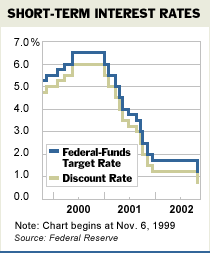

 Mini
Fed Challenge
Mini
Fed Challenge
This assignment is designed to expand your understanding of the Federal Reserve System's unique role in the economy and the importance of Federal Open Market Committee (FOMC) decisions. The class will be divided into 3-4 member teams. Each team will undertake research, and analyze data about current and near-term economic conditions. The student teams will conduct a mock meeting of the Federal Open Market Committee at the end of class. During this meeting teams will decide on and recommend a specific course for monetary policy by deciding whether to raise, lower, or maintain interest rates.
A FOMC-style "Statement" (i.e., Press Release) will be written. The statement will describe a specific course and rationale for monetary policy. There are no "right" or "wrong" answers. The first paragraph describes current economic conditions using "coincident economic indicators" for economic growth (e.g., gross domestic product), price stability (e.g., consumer price index), and full employment (e.g., unemployment rate). The second and third paragraphs describe future economic conditions using the leading economic indicators.
Leading Economic Indicators
Leading indicators anticipate the direction in which the economy is headed.
Producer Price Index
The PPI measures average changes in selling prices received by domestic producers and the first purchaser of output. It does not measure price changes that occur between the wholesaler and the retailer. The PPI is a leading indicator for the consumer price index. Increases (decreases) in the PPI inflation rate tend to lead to increases (decreases) in the CPI inflation rate.
Money supply
The M2 money supply includes currency, demand deposits, other checkable deposits, travelers checks, savings deposits, small denomination time deposits, and balances in money market mutual funds. There is a positive correlation between M2 and the price level. In other words, increases (decreases) in the inflation-adjusted money supply may lead to increasing (decreasing) inflation.
Note: To convert the nominal M2 to real M2, divide 100 x M2 by the consumer price index.
Average Weekly Hours of Production Workers in Manufacturing
The average hours worked per week by production workers in manufacturing industries tend to lead the business cycle because employers usually add (subtract) work hours before increasing (decreasing) their workforce.
Initial Unemployment Insurance Weekly Claims
The number of new claims filed for unemployment insurance are typically more sensitive than either total employment or unemployment to overall business conditions, and this series tends to lead the business cycle. Initial claims tend to increase (decrease) when economic conditions worsen (improve).
New Private Housing Units Authorized by Local Building Permits
The number of residential building permits issued (i.e., "building permits) is an indication of construction activity, which typically leads most other types of economic production. Another measure of residential construction is "housing starts" (i.e., New Private Housing Units Started). New permits tend to increase (decrease) when economic conditions improve (worsen).
Manufacturers' New Orders, Durable Goods Industries
New orders received by manufacturers in nondefense capital goods industries leads actual production because new orders directly affect the level of both unfilled orders and inventories that firms monitor when making production decision. Durable goods orders tend to increase (decrease) when economic conditions improve (worsen).
Index of Consumer Expectations
This index reflects changes in consumer attitudes concerning future economic conditions and, therefore, is the only indicator in the leading index that is completely expectations-based. Data are collected in a monthly survey by the Conference Board and by the Institute for Social Research at the University of Michigan. The index tends to increase (decrease) when economic conditions improve (worsen).
Advance Monthly Retail Sales for Retail Trade and Food Services
Sales at retail outlets make up about 40 percent of the personal consumption expenditures component of GDP. Consumers are anxious to increase spending when the economy is recovering and reluctant to reduce spending until they must. Retail sales do not fall until after a recession begins. The statistic is therefore a leading indicator for recoveries.
Yield Curve (i.e., Interest Rate Spread)
The spread or difference between long and short term interest rates is often called the yield curve. This series is constructed using the 3-month, 6-month, 1-year, 2-year, 5 year, 10-year and longer Treasury bond rates. It is felt to be an indicator of the stance of monetary policy and general financial conditions because its positive slope steepens (flatters) when short term rates fall (rise). When its slope becomes negative (i.e., short rates are higher than long rates and the yield curve inverts), it is a strong indicator of recessions.
Standard & Poor's 500 Stock Index
The Standard & Poor's 500 stock index reflects the price movements of a broad selection of common stocks traded on the New York Stock Exchange. Changes in the stock index can reflect both the general sentiments of investors. The S&P500 tends to increase (decrease) when conditions improve (worsen).